Things to see in Santa Flavia
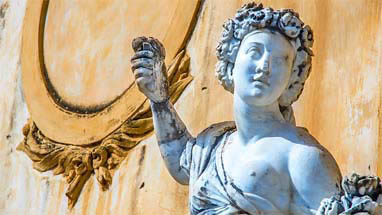
Santa Flavia is a great jumping off point for those enjoying their holidays and wishing to explore. The town and its surroundings seem to squeeze all of the wonders of the island into one small area. Why travel for days and days when there is so much to discover right here? For example:
- Only in Santa Flavia can you find an ancient town whose basic layout is still preserved.
- You can relax in a spacious aristocratic garden – free of charge.
- An outdoor cinema - "Cinema Paradiso" under the stars – a rarity in Sicily.
Much of the information on our site comes from Santa Flavia herself. In her stories and quiet corners we've learned things that don't exist on any bookshelf. Grazie mille!
Author
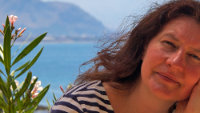
The information on this site comes from our Sicily expert Britta Bohn.
Britta has been dealing with daily life and life in Sicily for over 20 years.
Don't miss any of her tips! Subscribe to our free Newsletter:
An Invitation
Dear friends of Sicily, we invite you to join the Facebook Group "Trip-Tipp Sicily". Find answers to all your questions and discover exclusive tips for your trip to Sicily from those who have already made the journey and those who already know the island from the inside out:
Content
- Villa Filangeri - where The Leopard might have been
- Filangeri Garden
- The Basilika - A church with connections
- The Villas of Santa Flavia
- Beati Paoli - Heroes or criminals?
- Neptune and the way to the sea
- The rebel orphanage
- Sicily's Marionette Theatre - Culture Heritage in Santa Flavia
- Cinema Paradiso under the stars
- Francesco Paolo Perez - A kingdom of Sicily
- Padre Pio - Holy man or charlatan?
- Porticello - The port of Santa Flavia
- Borgo di Santa Nicolicchia - Bay with a view
- Sant'Elia has its secrets
- Capo Zafferano - Napoleon's hat
- Solunto - Santa Flavia in antiquity
Holidays lettings in Sicily
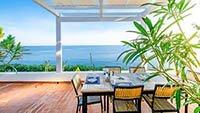
Are you looking for holiday lettings in Sicily but can't see the wood for the trees? We're not surprised, because the range of choices competing online is pretty confusing.
To make it simple, we present a small selection of quality holiday rentals, each one chosen for an unusual feature to make your holiday in Sicily extra special... more
Fashion made in Sicily

Sicilian fashion? Dolce & Gabbana?
Sure! But fashion designed and manufactured in Sicily is the real insider tip.
Like that of the Sicilian designer Filly Cusenza from Bagheria. She creates wearable art made of fabric, thread and buttons. Her trademark and label name is the fancy cartoon girl Filly Biz... more
The Essence of Sicily

Villa Filangeri - where The Leopard might have been
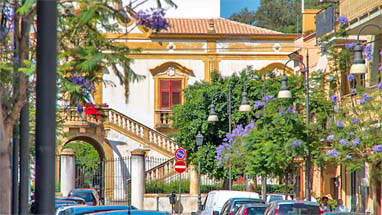
Are you a fan of classic Sicilian films? Then you might ask whether Villa Filangeri (brown Marker 2 on the city map) was that place you remember seeing in "The Godfather" or "The Leopard".
We hate to disappoint – to our knowledge neither film used Villa Filangeri. But it has all the qualities you'd expect in a location for either film, especially The Leopard. The villa captures brilliantly the start of the fall of the Sicilian nobility and the creation of the Italian state.
The Filangeri were part of the Sicilian nobility as far back as the Middle Ages. In those days the whole island fell under the ultimate control of the Pope, and later from around 1300 to 1860 it was dominated by Spanish kings. The Spaniards used Sicily for fiefdoms for the aristocracy. Santa Flavia was given to the Filangeris in the 17th century.
They soon built the Villa bearing their name and next to it a small chapel. This chapel grew into the Basilica Soluntina di Sant'Anna, the main church of Santa Flavia. Behind the Villa the Filangeri put a vast Mediterranean garden. – That's what you call good living.
Then came the year 1860: Italian patriots expelled the Spaniards and established Sicily as one of the first regions of the new Italian state. The Spaniards naturally thought of these people as terrorists. But the nobility had to come to terms with the change, unable to stop the formation of the bourgoisie and the democratic system.
Today democracy is in full bloom, despite past setbacks like fascism and the Mafia. The Villa Filangeri now belongs to the city of Santa Flavia and the freely elected mayor resides there.
But what became of the Filangeri? Al Stefanelli, an American author, civil rights activist, and descendant of the Filangeri, has assembled everything he could find about the Filangeris. The most prominent member of the clan today is the artist Beatrice Feo Filangeri (active on Twitter and Facebook). This video gives a glimpse into her Pop Art and baroque-influenced work:
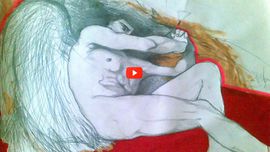
Filangeri Garden
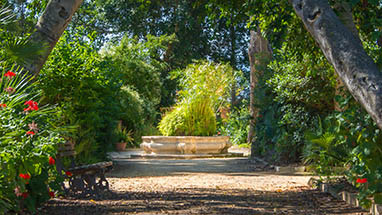
The Lion sleeps tonight...
Any real Sicilian villa has a giant garden, and in Santa Flavia the nobles built a true oasis (brown Marker 1 on the city map). Every Mediterranean garden always has certain features: water games, sacred statues, palm trees, and, of course, blossoming flowers.
But the Filangeris were in the mood for something exotic. So the garden behind what is today City Hall became home to a lion and a pack of monkeys.
The old people today still remember seeing the lion in their childhood, who was by then old and tired. But other animals still live in the garden to this day including geese, ducks, and chickens (which are far less dangerous). You can explore the garden today and sit on a bench to relax while listening to the fountain and taking in the sunlight through the scattered treetops.
The opening hours correspond to those of Town Hall, so between 9:00 and 16:00 you can visit the garden for free during the week. Just walk through the archway just off to the left side of Villa Filangeri.
The Basilica – A church with connections
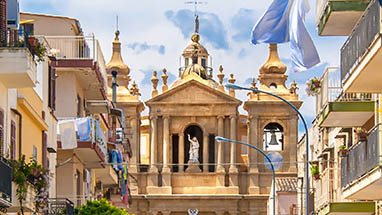
The Filangeri not only splurged on a huge garden, but on their own church (brown Marker 3 on the city map). It was just a small chapel at the start next to the villa, but was gradually expanded and extended into a basilica. A crypt was built under the altar which was connected to the garden by an underground tunnel.
So they had a sense of the dramatic in Santa Flavia – one didn't use the main entrance like the common folk, but rather one did appear as if by magic courtesy of a secret passage.
Today, of course, the gimmick would merit a tired smile. But in days of yore when ordinary people lived in tiny, squalid huts, the magnificent church was a place of majesty and even the supernatural. The normally golden Sicilian sun was transformed by stained glass into a kaleidoscopic display of colored light. Incense and incantations in a mysterious language (Latin) all spoke of something "higher".
The convenient alliance between church and aristocracy would be criticized by many, of course – including a local resistance group: the Beati Paoli.
The Villas of Santa Flavia
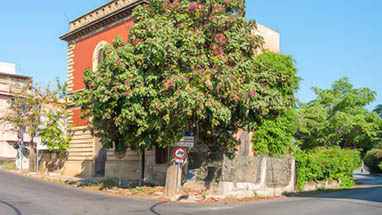
Nearby Bagheria usually gets the title "City of Villas". It was there, of course, that so many rich nobles from Palermo built their palatial summer homes in the 17th century - back when "holidays in Sicily" meant a day's ride by carriage.
But in the 1800s the railroad came to Santa Flavia and everything changed. Travel in Sicily had never been quicker. The wealthy were no longer limited by horse and carrage in finding their summer getaways.
A new wave of Palermo's elite flooded into the countryside – this time by train. This is why even today so many Art Nouveau-style villas can be found in the vicinity of the train station (blue Marker 1 on the map).
The best-known of these is right at the railway crossing - Villino Basile (brown Marker 10; see image). The builder - Ernesto Basile – was one of the most prominent architects in Sicily. His most famous work is the Teatro Massimo in Palermo. Basile was known throughout Italy for making the north facade of the parliament building in Rome.
More aristocratic buildings can be found near Villa Filangeri and the Necropolis (brown Marker 7 on the city map). Some of them date from the same period as Villa Filangeri, but most come to us from the second half of the 19th century. Though these villas are not open to the public, the sight from outside is very impressive.
Beati Paoli - Heroes or criminals?
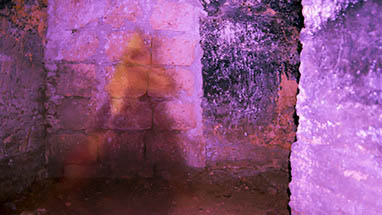
Digging around in Santa Flavia - for example, to lay the foundation for a new building – often leads to a shocking discovery: old tunnels (see right side of photo).
What is hard to see in the image is that the tunnel not only leads right, but straight. As the owners of the house above the tunnel explained to the photographer, they contacted the Carabinieri (police) about the tunnels as far back as the 1990s.
Not for technical or building code reasons. But because of the Mafia. The fact was, that the Mafia in those days was under such pressure it was returning to its roots – by going underground.
But the story goes back farther than that. In fact, underneath Palermo is shot through like swiss cheese with tunnels. It started in antiquity with cemeteries such as the one in Santa Flavia (brown Marker 7 on the city map). In the Middle Ages the Arabs built kilometers of irrigation tunnels – the famous Qanat.
And this is where the Sicilian version of Robin Hood begins. If you can believe it, the tunnels were the secret underground highways of the Beati Paoli or "knights" as they called themselves. They used these darkened tunnels in their fight against feudalism and the Inquisition. The video below shows a recreation of a typical Beati Paoli operation: hooded men in black cloaks standing in judgment over a captured nobleman.
Whether historical fact or overblown legend, one thing is almost certainly a bizarre twisting of history: the self-representation of the Sicilian Mafia as successors to the Beati Paoli. A pleasing tale for those "men of honor"!
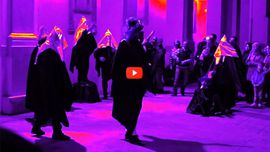
Neptun and the way to the sea
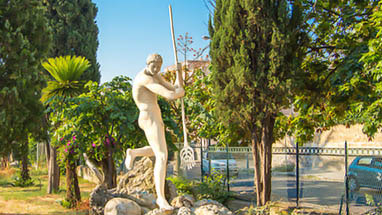
Every time you walk down to the sea in Santa Flavia you will reach the railroad crossing. And it's there that you'll encounter the ancient Roman sea god Neptune (brown Marker 9 on the city map).
True – it's a rather modern take on the olden god of the sea who was classically depicted as having wild hair, a beard, and of course, a trident.
Our Neptune was created by Tommaso Piscitelli (1877-1956). He hailed from Giovinazzo, a small town in Puglia.
It's no surprise that copies of our Neptune can be found in other cities in Puglia. One place it appears is in the Fountain of the Fishermen in Bari. In the 1930s a certain Ernesto Perez was prefect of Bari. Perez not only came from Palermo, he had been prefect in Palermo, too. Moreover, he lived in Santa Flavia – just across the way from Neptune.
In Santa Flavia, Neptune not only marks the way to the sea, but the way to a small park as well. It used to lead to the old train station waiting area. But with time and city development, the old waiting room disappeared. Today citizens enjoy the park and the fountain instead.
The rebel orphanage
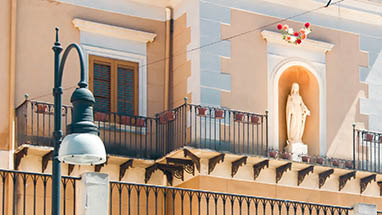
Opera Pia – which had its name as far back as the Middle Ages – was a charitable foundation whose beginnings, of course, were religious.
By the 1860s, with the winds of change blowing in the budding Italian state, Opera Pia's operations expanded to include education. This, in fact, was sorely needed as around 90% of Sicilians were illiterate.
Opera Pia would come to be faced by another problem though, especially in southern Italy: the high number of orphaned children. There were a great number of them in the mid-19th century in Sicily. Today, in fact, when you encounter the surname "Esposito" you are finding the descendants of a one-time orphan. The name comes from the Latin "expositus" which meant exposed or abandoned, but also "transfer of use".
This latter is no coincidence: in antiquity, orphans were very often used as slaves, and thus ownership was often "transferred". Luckily, in the newly-established Italy of the 19th century, this was no longer the custom. The orphanage in Santa Flavia with its new responsibilities was given the official title "Opera Pia Orfanotrofio Giuseppe Pezzillo" (brown Marker 5 on the city map).
What did it mean? "Orfantrofio" means orphanage. But “Giuseppte Pezzillo” was the name of a freedom fighter for the cause of a national Italian state. Of course, he was considered a terrorist by the ruling Bourbon elites, whom he rebelled against in Naples in 1848.
Giuseppe Pezzillo didn't survive the uprising he started, but his name was given to Santa Flavia's historic orphanage.
Sicily's Marionette Theatre – Culture Heritage in Santa Flavia
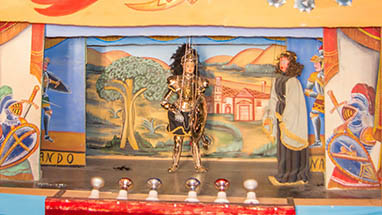
The loud clatter of swords, cries in Sicilian, and lots of enthusiastic applause. Could holidays in Sicily get any better?
The beautifully crafted, 150cm-tall marionettes act out a tale of the great Charlemagne and his knights fighting the Saracens. The performance is not only entertaining – it's a deep-rooted Sicilian tradition.
For many decades, the puppet show has been a real draw for both young and old. Stories like "The Frenzy of Orlando" were the topic of conversation in surrounding villages and neighborhoods.
In 2008, this Sicilian art form was recognized by UNESCO was being a part of the cultural heritage of mankind. But it hasn't gone to anyone's head. In Santa Flavia there is a "puppet theatre" (brown Marker 4 on the city map) where you sit in very close quarters and are granted by the "pupari" (puppeteer) a glimpse backstage after the show.
Cinema Paradiso under the stars
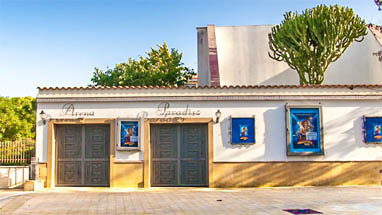
Anyone who passes by on a balmy night will hear music, loud laughter, and sometimes gasps of fright at Arena Paradiso (brown Marker 11 on the city map), and truly feel the special atmosphere that this "cinema under the stars" creates.
Many will recall the famous film Cinema Paradiso by director Giuseppe Tornatore. The film was shot nearby and the director's birthplace - Bagheria – is right next door. Other locations include Palazzo Adriano, Cefalù, Bagheria, Termini Imerese - and Santa Flavia!
There's something very cinematic going on here as these photos show.
But the drama doesn't end there. You may find yourself wondering – during a visit to Arena Paradiso while enjoying your holidays in Sicily – why there might be two "conspicuously inconspicuous" gentlemen in front of the cinema. It's because one of the cinema's greatest enthusiasts is the famous mafia-hunter Nino Di Matteo. Why after all the setbacks to the Mafia are bodyguards still needed? Because Di Matteo continues to investigate one of the never-ending themes of Italy: the relationship between the Mafia and political figures. That hasn't earned him any friends.
Francesco Paolo Perez - A kingdom of Sicily
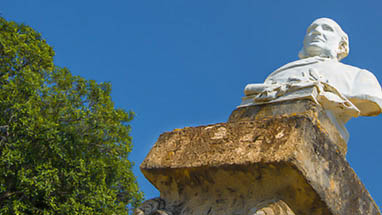
1848 – the year of revolutions. Switzerland becomes a state, Vienna has its October insurrection, and in Frankfurt the first ever German parliament meets. And where was the spark for all this created? In Palermo! It started here in January 1848 – an uprising against the Bourbons.
The revolt in Palermo came to be known as the "Sicilian Revolution of 1848" and proclaimed a new Sicilian kingdom. What they had in mind was a constitutional monarchy – or what today is regarded in Europe as normal.
One of major players in the Palermo revolt was a writer: Francesco Paolo Perez. He was an ardent supporter of an independent Sicily, and was at the very beginning one of the heads of the new Assembly.
In March a Sicilian parliament convened, officially announcing the birth of the new kingdom. There was one problem, however: no one wanted to be king. And more and more it appeared that the revolution was not leading to its desired outcome: a Sicilian republic.
So the inevitable happened. Just one year after the revolution began, the Bourbons retook Sicily. And ironically, the troops were commanded by a general named Carlo Filangieri – himself coming from the Neapolitan branch of the clan.
Today Francesco Paolo Perez is honored by Santa Flavia with a statue in from of the train station (brown Marker 8 on the city map). Patriotic citizens take care of the monument.
Padre Pio - Holy man or charlatan?
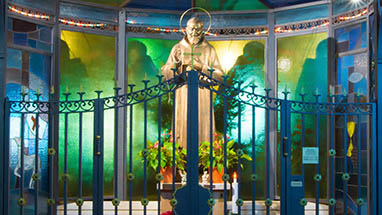
The Capuchin monk Padre Pio (1887 - 1968) is a cult figure in southern Italy and is likewise venerated in Santa Flavia. His image hangs in restaurants, cars, and even above marital beds. A colorfully lit statue of this Christian "pop star" stands at Via Consolare (brown Marker 6 on the city map), used as a meeting place for local youth.
Padre Pio felt his piety quite early, and became a monk at 16 after a childhood beset by illness - which seemed to only strengthen his devotion. When he appeared to have bloody stigmata on his hands after a prayer session, believers began to see him as holy.
During his Mass he seemed entranced. Non-believers asked drugs or insanity was involved. Pope John XXIII was opposed to the "strange monk with the piercing gaze and the suffering face".
Some have said that Pio's stigmata were created by applying carbolic acid. But what are rational explanations when it comes to religion? One will either be moved or flabbergasted by the colorful processions honoring Padre Pio in every Sicilian village
In Santa Flavia there are other festive displays. For example, the "Festa della patrona Sant'Anna" is celebrated in late July with light jewelry, music, and fireworks. A spectacular boat procession called the "Festa della Madonna del Lume" happens in Porticello every October. Holidays in Sicily are made unforgettable by these colorful social displays unique in all the world.
Porticello - The port of Santa Flavia
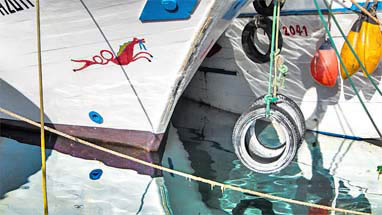
Porticello is a district within Santa Flavia. At least, it is so officially. But the people of Porticello see it differently. They say there was Porticello long before there were Filangeri.
In those olden days, the residents came from the warmer interior in order to fish. There was a natural harbor and even nearby caves where they could stay. The name "Porticello" dates from this period. It means "little port".
Over time more and more fishermen decided simply to stay. Houses came to be preferred to caves, and the natural harbor became Sicily's biggest fishing port. No surprise then that the port (Marker 12 on the city map) is the center of life in Porticello.
And no wonder that the patron saint of Porticello (Santa Maria del Lume) is the patron saint of fishermen in general. Older residents tell of miraculous rescues at sea linked to this figure. Listeners who aren't religious will perhaps regard these as yarns, but one should listen closely in any case: fishing is even today one of the world's most dangerous occupations.
This is why the patron saint is treated with a great deal of local reverence. Each year a procession begins in the church (brown Marker 13 on the city map) and travels across the sea to a small chapel at Capo Zafferano. From there it returns to the church:
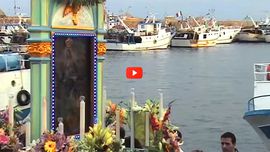
Borgo di Santa Nicolicchia - Bay with a view
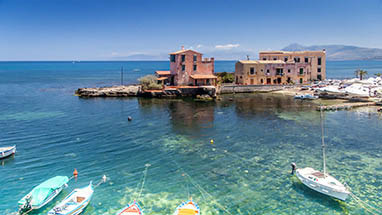
The Borgo di Santa Nicolicchia may well have been the whole reason why Porticello came to be in the first place. The map (brown Marker 14) and the image on the right show why: Borgo di Santa Nicolicchia is a perfect natural harbor.
In fact, in the 15th century there was a chapel standing on the pier that sadly no longer exists. It was devoted to St. Nicholas – which is where the name of the harbor came from.
The story goes that one day fishermen pulled up paintings of Santa Maria del Lume in their nets. They went straight to the chapel with them and declared her the patron saint of the town and the harbor.
Today the Borgo di Santa Nicolicchia is used as a harbor for pleasure boats and as destination for relaxing walks. If you're lucky enough to visit for your holidays in Sicily, you'll also see a popular seafood restaurant (red Marker 22 on the city map), red Pizzeria (red Marker 23 on the city map), and above all – a marvelous view.
Sant'Elia has its secrets
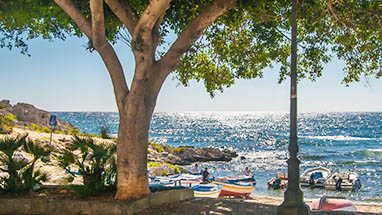
Sant'Elia is the most fascinating district in Santa Flavia. It opens onto the sea – which alone is worth a look for anyone enjoying the holidays in Sicily. But one should look closer. One of Sant'Elia's secrets is hidden at first but then reveals itself to the astonished observer in all its beauty: a rocky cove surrounded by old houses with balconies that seem to float as if by magic above the sea.
There are plenty of colorful fishing boats on the small beach (yellow Marker 3 on the city map) and in the middle of the bay is a staircase you can actually take into the water. A rock bearing a cross at the end of the estuary is a favorite spot of Sicilian locals for making marriage proposals.
Another secret is hidden in the walls of an old house standing practically in the middle of the sea – "Casa Bianca" (white house) at the end of the beach. Practically every day, some local dreamer remarks that it would be the perfect home since living there you have your feet in the water and head in the clouds.
But the house has some dark secrets according to author Stefanie Gerstenberger. Her novel The Lime House tells of the scent of citrus in its rooms, but also a secret rooted in old Sicilian tradition – which we, of course, cannot reveal here.
Capo Zafferano - Napoleon's hat
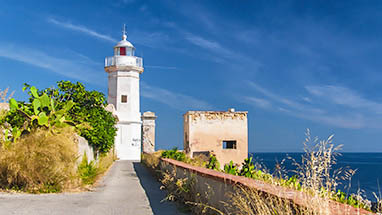
Lighthouses are fascinating. They stand alone against raging storms year after year, and throw their light into the darkness, silent signal for passing sailors.
The octagonal lighthouse at Capo Zafferano (brown Marker 16 on the city map) guards a beautiful coastline in northwest Sicily – whose cape draws the outer boundary of the Gulf of Palermo and is visible far out to sea.
The way to the lighthouse meanders its way along the sea – and is perfect for walking or a bike ride. Capo Zafferano's towering cliffs are rich with Mediterranean flora like samphire. Each cliff face seems to be its own ecosystem it is so teeming with life.
On the way, you'll likely be accompanied by seagulls that nest on the cape, and especially on the small rock outcropping "Lo Scarpone", so-called because it resembles a show. Capo Zafferano itself is nicknamed "Il Capello di Napoleone" – Napoleon's hat, though this is only visible from the sea.
Just before the lighthouse there is a staircase leading to a small chapel. From there you can enjoy a special view that you'll certainly remember from your holidays in Sicily: the entire coastline all the way to Cefalu. It's a beautiful little excursion, all in all, that brings you the sights and sounds of a special part of the world
Solunto - Santa Flavia in antiquity
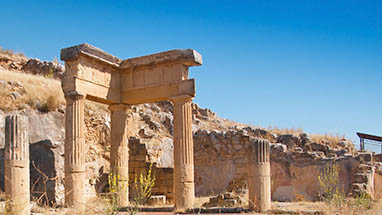
Santa Flavia is a popular destination not just today. People were scrambling to get here even in ancient times.
Luckily, while enjoying your holidays in Sicily you can see just what all the fuss was about in antiquity. The archaeological site is called Solunto – on the map brown Marker 15.
For archaeologists, Solunto is one of the most interesting ancient sites in Sicily, simply because for a long time it was completely forgotten. The last find at Solunto dates from the 3rd century in the form of coins. And from that time until the 1800s, Solunto seems to have simply fallen silent.
Of course, for archeologists this is ideal since so much is preserved. Indeed, Solunto is notable because its basic layout is still visible, showing exactly how it looked in antiquity. Solunto is billed as "ancient with breathtaking views" to vacationers today – and that is surely true. On this page you can find a detailed map of Solunto.